#Naples in the time of Napoleon
Text

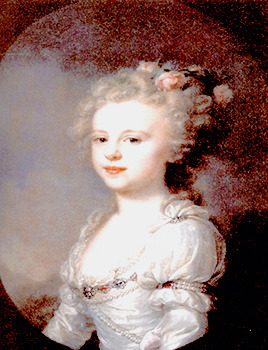

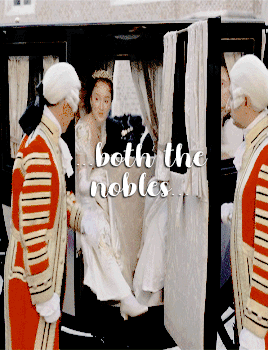
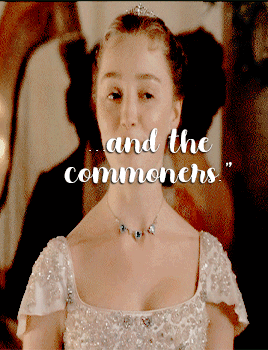
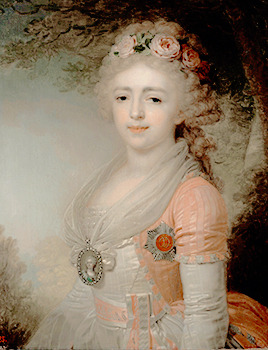
"In 1799, three years after her failed betrothal with the King of Sweden, another marital project originated for Alexandra. Previously in 1798, Dukes Ferdinand Augustus and Alexander Frederick of Württemberg who were the brothers of the Empress Maria Feodorovna, arrived in St. Petersburg to serve in the Russian army. They expressed the interest of Austria to join with Russia in a coalition against the rising power of the French Republic and Napoleon, and to cement this alliance, it was decided to arrange a marriage between Alexandra and Archduke Joseph of Austria, Palatine (Governor) of Hungary and a younger brother of Francis II, Holy Roman Emperor. Archduke Joseph personally came to Russia to see his bride. The meeting between them was successful. In mid-February 1799 the betrothal ball was held. Later, a marriage contract was signed in which Alexandra would be allowed to kept her Russian Orthodox faith. In October, Count Fyodor Rostopchin wrote:
"Believe me, that's not good started to strengthen the alliance with the Austrian court by ties of blood... Of all the sisters she will be given the least successful marriage. She will have nothing to wait for, and her children even more so."
On 25 September 1799, a decree was published about the royal title of Alexandra. In Russia, she was referred to as "Her Imperial Highness Grand Duchess the Archduchess of Austria" with the French prefix of "Palatine d'Hongrie". The wedding took place on 30 October 1799 at Gatchina Palace, one week after the wedding of her sister Elena. To celebrate both events, poet Gavrila Derzhavin wrote the ode "the wedding celebrations of 1799". On 21 November the couple went to Austria. Countess Varvara Golovina remembered that Alexandra was sad to leave Russia, and her father Emperor Paul I "constantly repeated, would not see her since her sacrifice." According to Alexandra's confessor, Andrei Samborski, Alexandra was given a cold reception in Vienna. However, other sources offer a different view. Queen Maria Carolina of Naples (the Emperor's mother-in-law) and her daughters arrived in Vienna in August 1800 for a long stay. Maria Carolina's daughter, Princess Maria Amalia of Naples, wrote in her journal that on 15 August the Queen and her daughters were introduced to Alexandra, whom she described as "very beautiful". Maria Amalia and Alexandra became friends during this time; and the Princess of Naples wrote in her journal that the Russian Grand Duchess and her husband had a friendly relationship with the rest of the imperial family and took part in the family gatherings, parties and balls in Vienna, which contrasts with the version given by Andrei Samborski. For instance, in January 1801, Maria Amalia wrote in her journal that the imperial family used to attend balls in Archduke Joseph's residence in Vienna, where "beautiful Alexandra, always serious and sad, has a magnificent household." When she was presented to Emperor Francis II, she reminded him of his first wife Elisabeth of Württemberg, who was her maternal aunt; this caused the jealousy of Empress Maria Theresa, Francis II's second wife, who also was envious of Alexandra's beauty and fine jewelry. Imperial confessor Andrew Samborski wrote:
"Remembering the happy cohabitation with her led him (the Emperor) in extreme confusion of mind which afflicted the heart of the Empress, his present wife. After this, she became in the innocent victim of the Empress' implacable vengeance...The Empress not forgotten and humiliated her parents and siblings when she called them a family of freaks, due to the treatment that Grand Duke Constantine gave to his wife."
Once, Alexandra turned up to a ball beautifully dressed, with magnificent jewellery. The Empress was incensed at being upstaged by the Archduchess, and ordered her to remove her jewellery, and also told her that she could no longer wear them. Heeding her instructions, Alexandra only decorated her hair with flowers when she attended a play some time later. The flowers highlighted her beauty, leading her to be applauded and being given a standing ovation, making Maria Theresa even more furious. Archduke Joseph could not protect his wife from these attacks. Furthermore, her Eastern Orthodox faith aroused the hostility of the Roman Catholic Austrian court, who urged her to convert. Pavlovna was popular among Hungarians, both the nobles and the commoners. According to the legend, it was her suggestion to add the color green as the third color to the flag of Hungary. Hungarians had been using red and silver, then red and green as their national colors for centuries at the time. However, in the late 18th century, a third color was proposed to be added to the flag, to follow the style of the French tricolor. Pavlovna suggested green as a symbol for hope. By the mid-19th century, the red-white-green Hungarian tricolor became widespread.
Wikipedia of Grand Duchess Alexandra Pavlovna.
81 notes
·
View notes
Text
After the Cake Incident with Marshal Lannes, My assistant, Mlle. Hopster has been telling me to make a blog myself. I finally gave into her pestering.
I'll probably make a better introduction at a later date, as by then I'll have a better gist of Tumblr.
I am Baron Dominique-Jean Larrey, Surgeon to Emperor Napoleons Imperial Guard. Feel free to ask whatever you like.
-Larrey
( This blog is run by @hoppityhopster23)
(Disclaimers: This blog does not provide professional medical Advice, nor am i a professional historian. I'm just well read about the history of medicine and enjoy reading about Larrey)
(Pfp by @cadmusfly)
------------------
Tags:
Responses from the the Baron - answers to any asks.
Conversations with the assistant - Conversations with my time traveler assistant. shes the one who convinced me to create this. shes also young, sometimes foolish, and likes to give people bad ideas.
Portraits of the Doctor - Images of me.
Comments from the Assistant - self explanatory
-------------------
Fellow Soldiers and marshals, etc (personal notes below):
Marshals Other Military Staff Royals Other
@armagnac-army - My Dear Friend Lannes, Marshal of France, Prince of Siewierz, and Duke of Montebello.
@murillo-enthusiast - Jean-de-Dieu Soult, Marshal of France and Duke of Dalmatia. (I'm pretty sure he just tolerates me.)
@le-brave-des-braves - Michel Ney, Marshal of France, Prince de la Moskowa, and Duke of Elchingen. (He's very helpful, And I am grateful.)
@your-dandy-king - Joachim Murat, Marshal of France and King of Naples.
@chicksncash - Andre Massena; Marshal of France, Duke of Rivoli, and Prince of Essling.
@your-staff-wizard - Louis-Alexandre Berthier, Marshal of France, Prince of Neuchatel, Valangin and Wagram, and technically my boss.
@perdicinae-observer - Louis Nicolas Davout, Prince of Eckmühl, Duke of Auerstadt.
@bow-and-talon - Laurent de Gouvion Saint-Cyr, Marquis of Gouvion-Saint-Cyr, and a man I respect for giving the us Medical staff needed in life.
@general-junot - Duke of Abrantes, and General of the French army.
@askgeraudduroc - Also My good friend, Grand Marshal of the palace, Duke of Frioul, and head of the Emperors household.
@generaldesaix - One of my closest Friends. Unfortunately we didn't have a lot of time together in life. nut now we do.
@messenger-of-the-battlefield - Marcellin Marbot, an aide to an assortment of Marshals, and a man I met a few times in life.
@askjackiedavid - Jacques Louis David, neoclassical painter.
@carolinemurat - Caroline Murat, Queen of Naples, and sister of the Emperor.
@alexanderfanboy - Napoleon Bonaparte, Emperor of France.
@rosie-of-beauharnais - Josephine, the Empress of France.
@the-blessed-emperor - Alexander I, Tsar of Russia.
25 notes
·
View notes
Photo

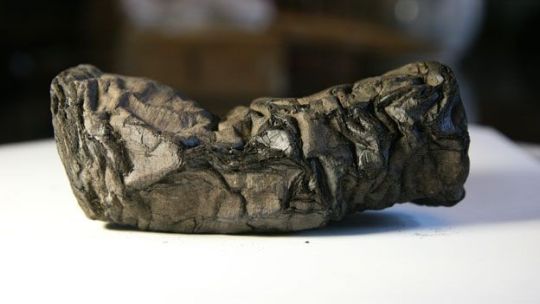
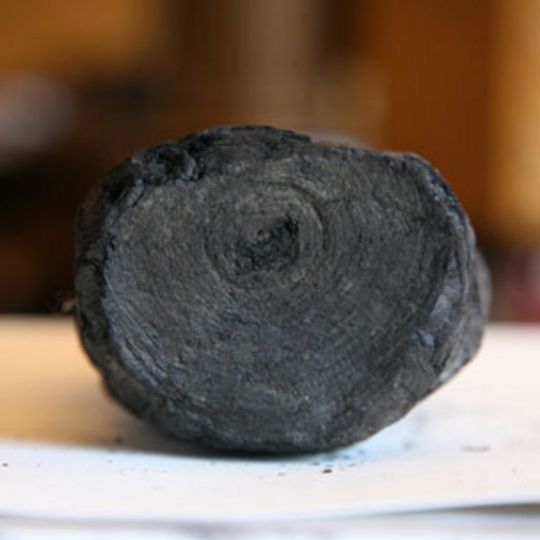







Ancient Herculaneum Scrolls Blackened by Vesuvius are now Readable
X-ray scans can just tease out letters on the warped documents from a library at Herculaneum.
The lavish villa sat overlooking the Bay of Naples, offering bright ocean views to the well-heeled Romans who came from across the empire to study. The estate's library was stocked with texts by prominent thinkers of the day, in particular a wealth of volumes by the philosopher Philodemus, an instructor of the poet Virgil.
But the seaside library also sat in the shadow of a volcano that was about to make terrible history.
The 79 A.D. eruption of Mount Vesuvius is most famous for burying Pompeii, spectacularly preserving many artifacts—and residents—in that once bustling town south of Naples. The tumbling clouds of ash also entombed the nearby resort of Herculaneum, which is filled with its own wonders. During excavations there in 1752, diggers found a villa containing bundles of rolled scrolls, carbonized by the intense heat of the pyroclastic flows and preserved under layers of cement-like rock. Further digs showed that the scrolls were part of an extensive library, earning the structure the name Villa of the Papyri.
Blackened and warped by the volcanic event, the roughly 1,800 scrolls found so far have been a challenge to read. Some could be mechanically unrolled, but hundreds remain too fragile to make the attempt, looking like nothing more than clubs of charcoal. Now, more than 200 years later, archaeologists examining two of the scrolls have found a way to peer inside them with x-rays and read text that has been lost since antiquity.
"Anybody who focuses on the ancient world is always going to be excited to get even one paragraph, one chapter, more," says Roger Macfarlane, a classicist at Brigham Young University in Utah. "The prospect of getting hundreds of books more is staggering."
Most of the scrolls that have been unwrapped so far are Epicurean philosophical texts written by Philodemus—prose and poetry that had been lost to modern scholars until the library was found. Epicurus was a Greek philosopher who developed a school of thought in the third century B.C. that promoted pleasure as the main goal of life, but in the form of living modestly, foregoing fear of the afterlife and learning about the natural world. Born in the first century B.C. in what is now Jordan, Philodemus studied at the Epicurean school in Athens and became a prominent teacher and interpreter of the philosopher's ideas.
Modern scholars debate whether the scrolls were part of Philodemus' personal collection dating to his time period, or whether they were mostly copies made in the first century A.D. Figuring out their exact origins will be no small feat—in addition to the volcano, mechanical or chemical techniques for opening the scrolls did their share of damage, sometimes breaking the delicate objects into fragments or destroying them outright. And once a page was unveiled, readability suffered.
"Ironically, when someone opened up a scroll, they would write on a separate sheet what they could read, like a facsimile, and the original ink, once exposed to air, would start to fade," says Brent Seales, a computer scientist at the University of Kentucky who specializes in digital imaging. What's more, the brute-force techniques usually left some pages stuck together, trapping hidden layers and their precious contents.
From 2007 to 2012, Seales collaborated with Daniel Delattre at the French National Center for Scientific Research in Paris on a project to scan scrolls in the collections of the Institut de France—former treasures of Napoleon Bonaparte, who received them as a gift from the King of Naples in 1802. Micro-CT scans of two rolled scrolls revealed their interior structure—a mass of delicate whorls akin to a fingerprint. From that data the team estimated that the scrolls would be between 36 and 49 feet long if they could be fully unwound. But those scans weren't sensitive enough to detect any lettering.
The trouble is that papyri at the time were written using a carbon-based ink, making it especially hard to digitally tease out the words on the carbonized scrolls. Traditional methods like CT scans blast a target with x-rays and look for patterns created as different materials absorb the radiation—this works very well when scanning for dense bone inside soft tissue (or for peering inside a famous violin), but the method fails at discerning carbon ink on blackened scrolls.
Now a team led by Vito Mocella of the Italian National Research Council has shown for the first time that it is possible to see letters in rolled scrolls using a twist on CT scanning called x-ray phase-contrast tomography, or XPCT. Mocella, Delattre and their colleagues obtained permission to take a fragment from an opened scroll and a whole rolled scroll from the Paris institute to the European Synchrotron in Grenoble. The particle collider was able to produce the high-energy beam of x-rays needed for the scans.
Rather than looking for absorption patterns, XPCT captures changes in the phase of the x-rays. The waves of x-rays move at different speeds as they pass through materials of various density. In medical imaging, rays moving through an air-filled organ like a lung travel faster then those penetrating thick muscle, creating contrast in the resulting images. Crucially, the carbon-based ink on the scrolls didn't soak into the papyrus—it sits on top of the fibers. The microscopic relief of a letter on the page proved to be just enough to create a noticeable phase contrast.
Reporting today in the journal Nature Communications, Mocella and his team show that they were able to make out two previously unreadable sequences of capital letters from a hidden layer of the unrolled scroll fragment. The team interprets them as Greek words: ΠΙΠΤΟΙΕ, meaning "would fall", and ΕΙΠΟΙ, meaning "would say". Even more exciting for scholars, the team was able to pick out writing on the still-rolled scroll, eventually finding all 24 letters of the Greek alphabet at various points on the tightly bundled document.
Even though the current scans are mostly a proof of concept, the work suggests that there will soon be a way to read the full works on the rolled scrolls, the team says. "We plan to improve the technique," says Mocella. "Next spring we have an allowance to spend more time at the Grenoble synchrotron, where we can test a number of approaches and try to discern the exact chemical composition of the ink. That will help us improve the energy setting of the beam for our scan."
"With the text now accessible by virtue of specialized images, we have the prospect of going inside the rolled scrolls, and that's really exciting," says Macfarlane. Seales agrees: "Their work is absolutely crucial, and I am delighted to see a way forward using phase contrast."
Seales is currently working on ways to help make sense of future scans. With support from the National Science Foundation and Google, Seales is developing software that can sort through the jumbled letters and figure out where they belong on the scroll. The program should be able to lump letters into words and fit words into passages. "It turns out there are grains of sand sprinkled all the way through the scrolls," says Seales. "You can see them twinkling in the scans, and that constellation is fixed." Using the sand grains like guide stars, the finished software should be able to orient the letters on the whorled pages and line up multiple scans to verify the imagery.
The projects offer hope for further excavations of the Herculaneum library. "They stopped excavating at some point for various reasons, and one was, Why should we keep pulling things out if they are so hard to read?" says Seales. But many believe there is a lower "wing" of the villa's collection still buried, and it may contain more 1st-century Latin texts, perhaps even early Christian writings that would offer new clues to Biblical times.
"Statistically speaking, if you open up a new scroll of papyrus from Herculaneum, it's most likely going to be a text from Philodemus," says MacFarlane. "But I'm more interested in the Latin ones, so I would not be unhappy at all to get more Latin texts that are not all banged up."
For Mocella, being able to read even one more scroll is crucial for understanding the library and the workings of a classical school of philosophy. "Regardless of the individual text, the library is a unique cultural treasure, as it is the only ancient library to survive almost entire together with its books," he says. "It is the library as whole that confers the status of exceptionality."
The scanning method could also be useful for texts beyond the Roman world, says Seales. Medieval books often cannibalized older texts to use as binding, and scans could help uncover interesting tidbits without ruining the preserved works. Also, letters and documents from the ill-fated Franklin expedition to the Northwest Passage in the 19th century have been recovered but are proving difficult to open without doing damage. "All that material could benefit from non-invasive treatment," says Seales.
By Victoria Jaggard.
#Ancient Herculaneum Scrolls Blackened by Vesuvius are now Readable#library at Herculaneum#Mount Vesuvius#The Villa of the Papyri#archeology#archeolgst#ancient scrolls#ancient artifacts#history#history news#ancient history#ancient culture#ancient civilizations#roman history#roman empire#roman literature#long reads
213 notes
·
View notes
Text
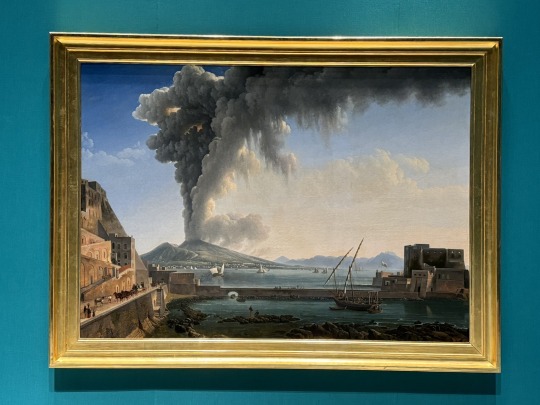




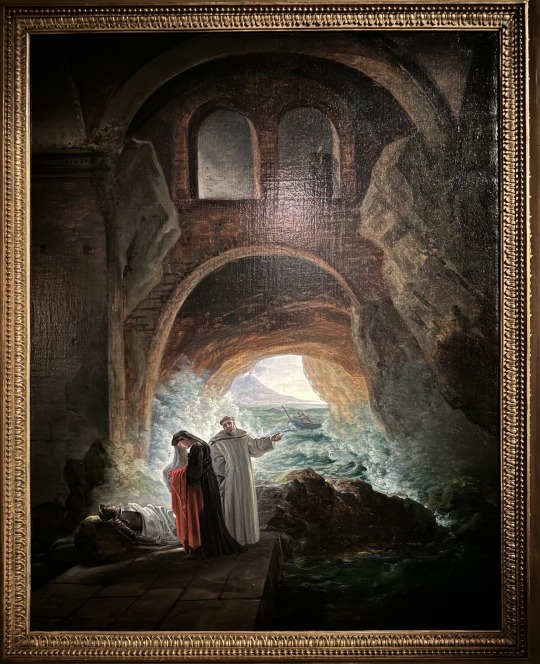




Naples a l'époque de Napoléon : Rebell et la lumières du golfe
Naples in the time of Napoleon. Rebell and the light of the Gulf
Naples in the time of Napoleon. Rebell and the light of the Gulf restores the atmosphere and image of the city in the years from 1808 to 1815, when Joachim Murat and his consort Caroline Bonaparte, the youngest of Napoleon's three sisters, were the much-loved rulers of Naples. This was a period of progress and renewed splendour for the kingdom, marked by extraordinary social, economic and urban transformations and particular attention towards the territory. The culture of the Murats and their modern taste acquired in Paris gave the arts a considerable boost, dividing their time between the official royal palaces of Naples and Caserta and their favourite private residence in Portici.
Patrons of the great portrait painters, Joachim and especially Caroline showed a particular sensitivity for veduta and landscape painting, calling French masters in the genre to their court, Special protection was reserved for the Viennese artist Joseph Rebell, who, along with other specialists in veduta painting, features prominently in this exhibition. Rebell spent several periods of time in Italy between 1812 and 1824, particularly in Naples.
Views of the city, its gulf and magnificent surroundings were his favourite subjects, even after leaving Naples in 1815, fuelling in Europe the myth of the unique nature of this enchanted land celebrated by the painters of the Grand Tour. His training and success are evoked and set against the backdrop of the cosmopolitan Neapolitan scene between the end of the 18th century and the second decade of the 19th century, marked by the presence of numerous travellers and landscape painters who profoundly renewed the vision of reality.
The Murat family itself is also a protagonist of the exhibition, with the presence of numerous portraits, paintings and sculptures bearing witness to the important role it played at that time.
The works are on loan from prestigious organisations, including the Belvedere of Vienna, partner of the exhibition, other major Austrian museum, such as the Vienna Academy of Fine Arts and the Austrian National Library, and French museums such as the Château of Fontainebleau and Versailles.
The exhibition is curated by Sabine Grabner, Luisa Martorelli, Fernando Mazzocca and Gennaro Toscano, with the collaboration of the Institut français in Naples.
Dates: November 23 2023 - April 7 2024
(Gallerie d’Italia)
#Gallerie d’Italia#napoleonic era#napoleonic#Caroline#Murat#Caroline Bonaparte#Joachim Murat#napoleon bonaparte#first french empire#napoleon#french empire#france#19th century#Naples#Napoli#Italy#Joseph Rebell#Rebell#Neapolitan#Naples a l'époque de Napoléon : Rebell et la lumières du golfe#Naples in the time of Napoleon#Naples in the time of Napoleon. Rebell and the light of the Gulf#Rebell and the light of the Gulf#art#Rebell et la lumières du golfe#19th century art#1800s art#veduta
26 notes
·
View notes
Text
The Calendar of Monte Cristo: Chapter 1
When we were reading The Count of Monte Cristo last year, it occasionally bugged me that I couldn't find a timeline of the events - whenever I went searching for one, all I could find were timelines of the writing and publication of the novel. So this time around I'm going to make notes and maybe make my own.
c.1785-1791: Napoleon Bonaparte garrisoned at Valence. Policar Morrel serves in the same regiment. [H]
c. 1790: Danglars born. [R]
c. 1796: Edmond born. [R]
some time before 24 February 1815: Maximilien Morrel born. [R]
c. December 1814: Pharaon departs Marseille for a voyage to Naples, Trieste and Smyrna. [R]
Final voyage of Captain Leclère. Pharaon stops at Elba and Edmond entrusted with message. [R]
24 February 1815: Pharaon arrives Marseille. Edmond speaks to M. Morrel, visits father and Mercédès. [E]
E: date explicitly stated in text
H: historical event
R: located relative to another event
#the cristo account#the calendar of monte cristo#chapter 1#the count of monte cristo#alexandre dumas#not a reblog
28 notes
·
View notes
Note
I was wondering the other day, did the people from Napoléon’s “inner circle” that became rulers ever learned the languages of their subjects? Could Murat speak Italian or did Bernadotte speak Swedish? Did Louis and Hortense speak Dutch/Flemish and so on and so forth? :-)
Sorry for the late response. I honestly don’t have too many details on this. I can recall one reference from a while back about Murat practicing his Italian and Caroline teasing him for his pronunciation (apparently he would accentuate the wrong syllables). Louis Bonaparte attempted to study Dutch but I have no idea how good he became at it; I’d be willing to bet that between the brevity of his reign and how busy he must’ve been, he probably didn’t attain fluency. Becoming fluent at a new language, especially once you’re well into adulthood, is extremely difficult—speaking from personal experience studying multiple languages over the years. (See also Napoleon’s failed attempt to learn English on Saint Helena.) As for Hortense, she was never emotionally invested enough in Holland to even be bothered to make the attempt; in her memoirs, she recounts leaving Holland in 1810: “As I drew nearer France I felt that I was being restored to life… The first custom-house officials we encountered made my heart beat faster because they spoke my language.” And regarding Bernadotte, it doesn’t appear that he ever learned Swedish, but as French was spoken at the court of Sweden at the time anyway (as it was also spoken at the court of Naples and most other European courts of the time), he would’ve done just fine without doing so.
17 notes
·
View notes
Text
Letter from Marie Louise to her father
Written shortly after the "handover" ceremony in Sankt Peter close to Braunau. For this ceremony, a wooden building, divided into three parts (French - neutral - Austrian), had been constructed, usually referred to as the "three pavillions" or "three barracks". The leaders of the two delegations, Berthier and Trautmannsdorf, both signed the contract before the bride was handed over to the buyer bridegroom's delegation.
Dearest Papa!
Forgive me for not immediately writing to you yesterday, as I should have done, but the journey, which was a little tiring and long, prevented me from doing so. Through Prince Trautmansdorf I have found another opportunity to write to you once more sincerely, and I am happy to seize it to assure you that I am constantly thinking of you and always will.
"Sincerely" here probably means "without measuring my words because I'm being spied upon by my new entourage".
God has given me the strength to endure happily even the last painful blow, the separation from all my loved ones, in Him alone I have all my trust, He will help me and give me courage, and I will find my reassurance in the consolation of having done my duty to you by making this sacrifice.
Yesterday I arrived in Ried very late, still preoccupied with the thought that I might be separated from you forever. Today I arrived at two o'clock in the French camp in the barracks at Braunau, after staying in the Austrian barrack for some time, I moved to a throne in the neutral barracks, after the papers had been read, all my people kissed my hand, at that moment I really didn't know what I was doing, a cold shiver overcame me and I became so upset that the Prince of Neufchatel began to cry.
Which must have been a sight to behold: Berthier crying tears of emotion while his new empress starts to panic and desperately looks around for the emergency exit.
Prince Trautmansdorf handed me over to him [...]
... and a kleenex, too ...
[...] and my entire court was presented to me, oh God, what a difference between the French and Viennese ladies! --- The Queen of Naples came to meet me in the other room, I embraced her, and showed myself remarkably friendly towards her, but I do not quite trust her, I believe that it was not zeal for service alone that was the cause of her journey.
That's a very interesting first assessment of Caroline Murat. Marie Louise may have been less naive than she made herself out to be.
She travelled with me to Braunau, and here I had to hold a two-hour toilette, I assure you that I am already as perfumed as all the other French women.
Apparently, the difference mentioned above was largely attributable to odour.
The Emperor Napoleon has sent me a splendid golden robe, but he has not yet written to me - if I had to leave you, I would much rather be with him than travelling with all those ladies.
That's one thing that will remain true for a large part, I believe. With the one exception of the duchess de Montebello, she did not really appreciate the ladies of the French court (and Louise Lannes she apparently appreciated to some extent because she was not much suited for life at court).
Oh God, how I regret not being able to still spend the happy days with you, only now am I learning to appreciate them. I assure you, dearest Papa, that I am very sad and cannot yet console myself. I hope your catarrh will be completely over; I include you in my prayers every day. Forgive my poor scribbling, but I have so few moments to myself, I will kiss your hands a thousand more times and have the honour of being
Dearest Papa!
Your most submissive and obedient daughter Louise
Braunau 16th March 1810
(Source: Helfert "Maria Louise, Erzherzogin von Österreich, Kaiserin der Franzosen", Wien 1873)
14 notes
·
View notes
Note
#I have thoughts on Pokémon teams for some of the marshals
omg pleaseee make a post about it i would love to read it <3
Made those tags on this post by @bambooale - and yeah, I love Pokemon ever since I played Pokemon Blue as a small child and named my Venusaur "AAAAAAAAA" so I definitely have pokemon thoughts!
I was thinking about answering this in the form of drabbles but I do have Assignments, but I am Tempted to write some silly fanfic about this at some point.
Edit: I wrote fanfic oops
Michel Ney and a Balloon
Young Murat and Bessieres and art by @apurpledust !!!
Anyway, using this page to put together pokemon teams for Lannes, Murat, Ney, Bessières, Soult, Masséna, Davout and Napoleon, and feel free to disagree or talk about your own thoughts!
-
Lannes

Dubwool, Ampharos, Aegislash, Diggersby, Ceruledge, Falinks
Obviously Lannes needs the two sheep(ish) pokemon in his team: Dubwool and Ampharos. Even if Ampharos loses its wool as it evolves, maybe he got it as a cute Mareep and still loves it.
The other pokemon are based on him as an infantry commander who participated in besieging fortifications - Diggersby for tunnelling, Aegislash and Ceruledge as... swords, ghostly swords who "fell before accomplishing their goal"
and Falinks, well, Lannes was known as the Roland or Achilles of the Grande Armee, Achilles was Greek, Falinks is kinda Greek-
but I was also thinking that Falinks fits Napoleon a lot as well, especially with seeing that drawing by bambooale-
What if Napoleon looked after Lannes' Falinks after he died?
Interesting thoughts.
-
Ney

Mudsdale, Pyroar, Armarogue, Talonflame, Lycanroc, Drifblim
The entire reason I started thinking about this was because I thought it would be extremely funny if Ney had a Drifblim because of the time a guy claimed to have invented a hot air balloon for battlefield reconnaissance, sold the idea to Ney and promptly disappeared with the money.
It would be even funnier if in Poke-verse, the guy sold Ney a Drifloon.
Mudsdale is because Ney started out as a hussar/cavalryman, Pyroar because "that man is a lion!", Talonflame is a brave bird that has the powerful recoil-causing moves Brave Bird and Flare Blitz, Midnight Lycanroc is red and loves to charge in, Armarouge is also red, loyal and gallant.
-
Murat

Rapidash, Milotic, Sylveon, Gallade, Sirfetch'd, Vanilluxe
Obviously a horse man needs a horsie, and a fiery unicorn is definitely up Murat's alley. As the beau sabreur of France, he also needs valiant swords-pokemon by his side, and also the most fashionable and beautiful pokemon with him, such as one that grows from an unassuming fish into a splendid creature and one that evolves with love and affection.
I was stuck on the last pokemon to give him. It's a bit anachronistic, but what if King of Naples had, uh, Neapolitan ice cream.
Sorry.
Also Rapidash and Sylveon go along with...
-
Bessières

Galarian Rapidash, Zebstrika, Swanna, Indeedee, Furfrou, Glaceon
Another horse man obviously needs a horsie, and look, I enjoy Murat and Bessières's friendship and shipping, I do like the idea of paralleling them with their Rapidashes and Eeveelutions.
I was thinking Umbreon because Umbreon is my favourite eeveelution and Umbreon evolves via happiness, but Glaceon's hair kinda fits and Bessières was described as seeming to be "cold". Ah well, I'm sure Glaceon loves him anyway.
Zebstrika is another horse, and Bessières is described as having eyes that "project lightning bolts". I think there's a description of his manor's lake having swans, and he did teach his men to swim at one point? Indeedee is a gentlemanly pokemon, and Furfrou, there was a claim that Bessières was a hairdresser at one point, and he does wear his hair in "dog ears".
-
Soult

Dachsbun, Appletun, Smeargle, Oranguru, Thievul, Skarmory
I could have filled this all up with baking jokes. Dachsbun, Appletun, Centiskorch, Alcremie, Slurpuff, uh, maybe I couldn't. Exeggcute. Anyway.
Soult had an appreciation for art and took some from the pieces that had already been looted, and I think with him being known for Strategy he might enjoy Smeargle's potential in learning Any Move. Oranguru is a teacher, Soult was a drill sergeant, same thing, right.
Thievul... Soult was not the worst plunderer but gained a reputation for being such. I was thinking a dark type to represent that reputation (as well as the Roi Nicolas thing) and tossing up between Liepard - as the Dalmatia coat of arms has leopards - and Thievul. But then I thought about the Duke of Wellington going "View Halloo! I have you now!" to Soult, years later, and the association of that kind of cry with fox hunting, and the legend of Wellington going fox hunting with French soldiers, and that clinched it.
Skarmory is because I wanted a steel type for Monsieur "Iron-Arm", a lot of steel-types I've already put aside for the obvious, and Skarmory is my favourite Pokemon. Their feathers harden in the thorny nests that they grow up in, that's totally like what Soult did at the camps of Boulogne right.
-
Masséna

Clefable, Klefki, Gholdengo, Persian, Sneasler, Grimmsnarl
I admit I got a bit stuck here.
Sneasler, Klefi and Grimmsnarl are inspired by Masséna as a smuggler before rejoining the army, with Sneasler helping out in the mountainous areas.
Clefable is based on thoughts of the "Dear Child of Victory" - I didn't want to use Legendaries here, otherwise there is Literally A Victory Pokemon - and I kinda characterise Masséna in my head as a gambler, so a pokemon with Metronome makes sense to me.
Persian and Gholdengo is because he did like his plundering and he was pretty salty about losing his "Livorno millions"!
-
Davout

Metagross, Bisharp, Lucario, Corviknight, Bastiodon, Swellow
Oh look this is where all the steel types went, to the Iron Marshal. I really wanted him to have Metagross and Bisharp as they'd make great buddies for a tactician and strategist, and then the other three steel types are also just cool for the goddamn Iron Marshal.
Swellow is purely because of the cute partridge story (and this is the second time I've referenced something @northernmariette has posted!). Swellow also has the ability Guts, where its attack rises if it is afflicted with a status problem. I think Davout is pretty gutsy, too!
-
Napoleon

Empoleon, Dragapult, Vespiquen, Clawitzer, Falinks, Braviary
Napoleon needs an Empoleon, the pokemon literally named after Napoleon.
Dragapult and Clawitzer are artillery pokemon. Vespiquen and Braviary are symbolic of the First French Empire, with Vespiquen's rulership over Combees being very fitting.
And Falinks could both represent the Grande Armee... and also be a remnant of his fallen friend.
-
Miiiiight write some fanfic for this if the inspiration hits and I survive this last week.
Thank you very much for the ask though! I leave you with a meme screenshot from the Pokemon game set in Pokemon France:

#apurpledust#napoleon's marshals#pokemon crossover#cad answers an ask#napoleonic au#jean lannes#michel ney#joachim murat#jean baptiste bessières#jean-de-dieu soult#andré masséna#louis-nicolas davout#napoleon bonaparte#napoleonic era#napoleonic wars#pokemon#napoleonic shitpost#long post#napoleonic pokemon au
22 notes
·
View notes
Text
I tried to look up with whom Caroline Bonaparte had affairs and I found this website through my research and I don't know how to feel about this because these comments are not detailed and objective enough for me EVEN THOUGH there are sources mentioned at the end. With all of this in mind, I wanted to ask you all if you know more about these points and if you can confirm to have read about these incidents:
Let's look at some points which let me be confused, shall we?
1. Did Lannes and Caroline ever have a relationship/situationship?
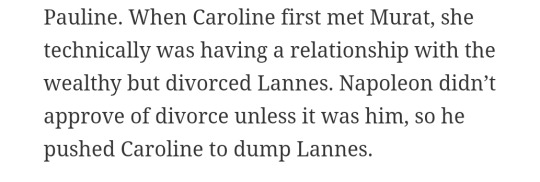
I was more confused than informed after reading these two sentences. Specifically the "unless it was him" part because I read it as if Napoleon made an exception for Lannes which he didn't? The structure of the sentence doesn't make any sense for me. At the same time, English is my third languages. Maybe I just need to read through my grammar books again and study... All of this aside, did they really have something going on?
2. Naps slapping Achille

I heard about the incident of Naps pulling at Achille's ear once but just randomely mentioning this was ???? And the thing is, this wasn't elaborated at all. When did this happen? How did this happen? How did Murat and Caroline react? I can imagine Murat getting quite protective. This incident is described as the Bonapartes disputing about something and then Napoleon slapping his nephew out of nowhere. And that's it...
3. Was Caroline really "thrilled" about the idea of staying Queen?

Pls, let me explain: I am aware of Caroline's ambitions but the verb "thrilled" sounds wrong in my eyes because, as far as I am concerned, it contains the fact that Joachim, the father of her four children, would be dead. She sounds like as if Murat didn't mean anything to her and... that wasn't the case, was it? I am open for corrections. I really want to learn.
4. This... just isn't true.

If I remember corectly, Murat's and Napoleon's relationship wasn't the best already (before Russia) because Murat wanted to reign in Naples and not to be a puppet of Napoleon.
Caroline and Murat themselves went through big highs and very big lows in 1810... i. e., Caroline went through a miscarriage.
5. Murat's indecisiveness considering leaving Napoleon's side after everything..

Gahwd, whoever wrote this, your choice of words is terrible. He wasn't an idiot. He was humane. . _.
6. Did all of the siblings really blame Caroline for everything that happened to Naps? As if they weren't done with his bullshit too... you can't tell me that Joseph wasn't just done after the peninsular war.

Why on earth would Napoleon blame Caroline for Russia? She wasn't there? In addition to that, Naps was a realist who liked to take risks and had ambitions. He is not delusional... 😭🤡
In conclusion: I am confusion.
#I am confusion#napoleon bonaparte#napoleon's marshals#joachim murat#napoleonic era#caroline murat#napoleon's family#jean lannes#Achille Murat
66 notes
·
View notes
Note
What the tea on Maria Carolina? You said in one of your posts: “Maria Carolina truthers know she's the most interesting daughter and the one there should be hundreds of books and movies about, but the general audiences haven't seen the light yet.” I’m intrigued
Hi! Sorry it took me so long; I was reading a book about the Bourbons in Naples and I wanted to finish it to be able to give a more complete answer… but it ended up taking me MONTHS to be done with it.
This answer was a bit difficult to put together because Maria Carolina’s life was very eventful, so I’ll just mention some facts about her life, focusing more on the Napoleonic era and Napoleon specifically because I think you’ll be more interested in that. Also please feel free to correct me If I got something wrong, since this is a time period I’ve only started to learn about recently. So what was the tea?
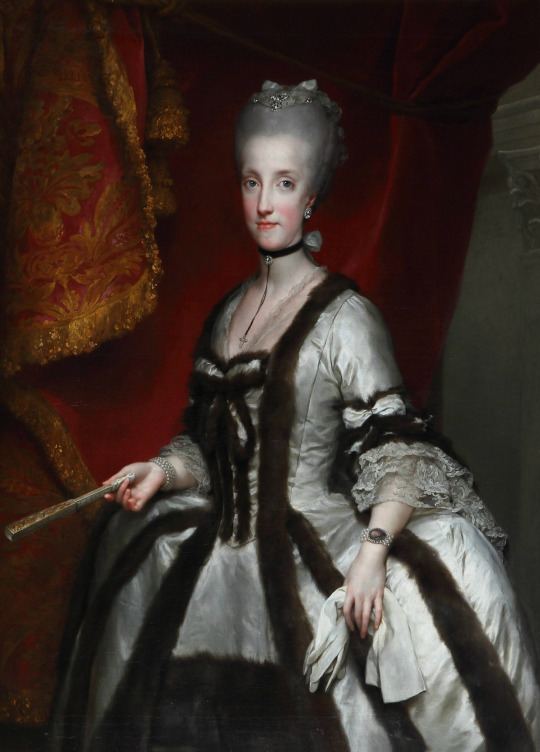
Born in 1752 Maria Carolina was the thirteenth child of Empress Maria Theresia and Franz I, Holy Roman Emperor. As part of her mother’s policies of rapprochement to the Bourbons, she and her siblings were engaged to different members of the houses of Spain, France, Parma and Naples. Maria Carolina was promised to the Dauphin of France, but when her elder sister, promised to the King of Naples, died of smallpox, she took her place.
Ferdinando of Naples had been a child king, and he remained so for the rest of his life. His only diversions were hunting and pulling pranks on his courtiers, and he had a terrible reputation across the courts of Europe as an uneducated, bad mannered, spoiled man, kept in ignorance by his Ministers so they could control him. Everyone pitied the young Archduchess’ fate, her mother Maria Theresia wrote around the time of Maria Carolina’s wedding that she “trembled in fear for her”. But duty came first, and so she went to Naples, aged only sixteen.
Maria Carolina did not had it easy at first. She was terribly homesick and found herself in a court that could not have been more different to the one she grew up in. When her sister Maria Antonia married the Dauphin of France, she wrote to her former aya:
When I imagine that her fate will perhaps be the same as mine, I want to write volumes to her on the subject, and I very much hope that she has someone like me [to advise her] at the beginning. If not, to be frank, she may succumb to despair. One suffers real martyrdom, which is all the greater because one must pretend outwardly to be happy. I know what it is like, and I pity those who have yet to face it… I would rather die than endure again what I went through at the beginning. Now all is well, which is why I can say—and this is no exaggeration—that if my faith had not told me, ‘Set your mind on God,’ I would have killed myself.
Unsurprisingly Maria Carolina didn’t fall head over heels for her husband, but she did convince him that she had, and eventually won his affection. After she bore a son in 1775 she earned a seat in the State Council (as her marriage contract established), and from that point onward she became an active player in Neapolitan politics. One of her firsts moves was to remove the Secretary of State, Marchese Tanucci, who had been Regent during her husband’s minority and still held a huge influence over him.
After Tanucci’s dismissal she became the person with the most influence over Ferdinando, and she pretty much had him wrapped around her finger for most of their marriage, acting as the de facto ruler of Naples. Every decision the king took was only after consulting his wife, and she often had the final say. However, this didn’t meant Maria Carolina held absolute power: Ferdinando was still a very unpredictable person, and as soon as his wife was out of his favor he stopped listening to her.
Maria Carolina was enthusiastic about the ideas of the Enlightenment, as many other royals were at first, and even protected and encouraged the Masons in Naples during her early years as queen. But she was still the consort of an absolute monarch that believed they were chosen by God to rule, so it shouldn’t come as a surprise that she was horrified by the French Revolution and fervently opposed it. If it were for her, she would've declared war on France immediately, but this was not possible. On the execution of her brother-in-law Louis XVI she wrote:
Knowing your upright mind, I can imagine your emotion on hearing of the appalling crime perpetrated against the unfortunate King of France in all solemnity, tranquillity and illegality (…) He was the head of our family, our kinsman, cousin and brother-in-law. What an atrocious example! What an execrable nation! I know nothing about the other wretched victims in the Temple. If sorrow does not kill them, other horrors may be expected from this horde of assassins. I hope that the ashes of this good Prince, of this too good Prince who has suffered shame and infamy for four years culminating in execution, will implore a striking and visible vengeance from divine Justice, and that on this account the Powers of Europe will have no more than a single united will, since it is a matter in which they are all involved.
She was growing increasingly anxious about her sister, Queen Marie Antoinette, and her hatred for France became an obsession:
I hear horrible details from that infernal Paris. At every moment, at every noise and cry, every time they enter her room, my unfortunate sister kneels, prays and prepares for death. The inhuman brutes that surround her amuse themselves in this manner: day and night they bellow on purpose to terrorize her and make her fear death a thousand times. Death is what one may wish for the poor soul, and it is what I pray God to send her that she may cease to suffer. . . . I should like this infamous nation to be cut to pieces, annihilated, dishonoured, reduced to nothing for at least fifty years. I hope that divine chastisement will fall visibly on France, destroyed by the glorious arms of Austria.
At this point she had lost all hopes of her being rescued, and wished her “a natural death as the best thing that could happen to her”. But even though she had been waiting for it, the news of Marie Antoinette’s execution still shocked her. She wept and prayed with her children for “her wretched sister”.
Naples fell into a social crisis during these years, paranoia, fear and suspicion of the revolution in every corner. There was an active persecution of everyone thought to be a “jacobin”, arrests, trials and executions. But the country couldn’t wage war against France, and eventually they had to sign a peace treaty, which the Queen disapproved: “I am not and never shall be on good terms with the French… I shall always regard them as the murderers of my sister and the royal family”.
It was also during this time that the star of a certain Bonaparte started to rise, and Maria Carolina followed his career with interest and admiration. Before the treaty of Campo Fornio in October 17, 1797, she wrote about Napoleon:
I admire him, and my sole regret is that he serves so detestable cause. I should like the fall of the Republic, but the preservation of Bonaparte. For he is really a great man; and when one can only see ministries and sovereigns with petty and narrow views, one is all the more pleased and astonished to watch such a man rise and increase in power, while deploring that his grandeur is attached to so infernal a cause. This may seem strange to you. But while I loathe his operations, I admire the man. I hope that his plans will miscarry and his enterprises fail; at the same time I wish for his personal happiness and glory so long as it is not at our expense… If he dies they should reduce him to powder and give a dose of it to each ruling sovereign, and two to each of their ministers, then things would go better.
Soon she would have less nicer things to say about Naps, but she never lost that original admiration and astonishment.
In 1798 Ferdinando, encouraged by his wife and the British, led a expedition in December to try to expel the French from Rome. Not only the Neapolitan troops weren’t prepared to defeat the French Army, they were also technically still at peace with France, so this wasn’t a good move at all, and only two days after entering Rome Ferdinando had to retreat. Expectedly, Napoleon’s reaction to such a break of peace was marching over Naples. The royal family had to flee to Sicily, a tragic journey in which Maria Carolina’s six-years-old son Alberto died after a series of convulsions.
This ask is already too long to unpack all the political mess around the short-lived Parthenopean Republic, so to summ it up: it didn’t work out, and by 1799 the Bourbons were back in power. They were unforgiving of the republicans: during the following months there were thousands of arrest and hundreds of executions and deportations. Maria Carolina felt no mercy for them: “Death for the ringleaders, deportation for the rest... Our country must be purged of this infection”.
The Queen returned to Naples in August 1802, after more than three years of absence. She had never been a liked queen, but her unpopularity reached a new low since she was blamed for all the misfortunes of the last years. Having lost the influence she had on her husband, who held her responsible for the Rome expedition fiasco, she meddled a little less in politics now, dedicating mainly to her children and grandchildren, particularly to her unmarried daughters.
Speaking of her children, she had seventeen (!!!) but she would outlive fourteen of them. Part of her masterplan for them was to marry them all to her Habsburg nephews and nieces, and in many cases she succeeded. Just to name one exemple her eldest daughter Maria Theresa married Emperor Franz II/I of Austria. Maria Carolina’s relationship with this son-in-law ended up being a bit tense, since Franz found her mostly meddlesome and never aligned with her plans. On top of that, she was quite hurt when Franz remarried only months after her daughter’s death; after he announced his engagement she stopped adressing him as her son and resorted only to “Your Majesty” instead.
In 1804 Napoleon became Emperor, and we have a letter she wrote to Minister Gallo on this. Buckle up because whatever you imagine her reaction was, you aren’t ready for it:
It was not worth the trouble to condemn and slaughter the best of kings [Louis XVI], dishonour and revile a woman, a daughter of Maria Theresa, a holy princess [Marie Antoinette], to wallow in massacres, shootings, drownings, and kill six hundred prelates in a church, perpetrating horrors of the most barbarous ages at home and abroad, writing whole libraries on liberty, happiness, etc., and at the end of fourteen years become the abject slaves of a little Corsican whom an incredible fortune enabled to exploit all means to succeed, marrying without honour or decency the cast-off strumpet of whom the murderer Barras was surfeited, Turkish or Mohammedan in Egypt, atheist at the start, dragging the Pope after him and letting him die in prison, a devout Catholic after that, practising every deceit, shortening the lives and normal careers of sovereigns who might assert themselves, only allowing the dummies to vegetate, then atrociously, without a shadow of justice, assassinating the Duc d'Enghien, plotting himself (and he did not blush to admit it, so blinded is he by passion) a conspiracy to victimize the rulers he still feared, and on top of all these abominations he is acclaimed as Emperor: he and his race of Corsican bastards are to dominate almost half Europe, yet every thinking person is not revolted. Far from it, their egoism and weakness are such that they study how low they can prostrate themselves before the new idol… Send me word of the august Emperor’s intentions regarding Italy: whether he will deign to accept us as his slaves or will leave us in our obscurity… Tell me what the other Powers are saying. I imagine a Gloria in Excelsis Demonio will be the general refrain…
She took it pretty well right?
The future of the Bourbons of Naples once again seemed bleak, and this time Maria Carolina resorted to directly appealing to Napoleon. This was the beginning of a very passive-agressive epistolary relationship, both of them trying to be civil but still borderline insulting each other. I honestly find this funny, because you have Maria Carolina swearing to Napoleon that she had nothing against him or France and then she would write this to one of her ministers: “You will never imagine the rage and despair which the extremely insolent screed of the scoundrelly but too lucky Corsican has caused me.”
Despite the passive-agressiveness, when Napoleon was looking for a princess bride for his stepson Eugène he actually considered one of Maria Carolina’s daughters, Maria Amelia, as a possible candidate. But when the Minister of Foreign Affairs Gallo told Maria Carolina of Napoleon’s inquiries about her daughter she was so utterly horrified at the idea of marrying into the Corsican’s family that the project was immediately dropped (eventually Maria Amelia would go on to marry the Duke of Orléans, later King Louis Philippe I, and became the last queen of the French).
After Austerlitz Napoleon pretty much had all of Europe eating from his hand, and the Neapolitan sovereigns felt abandoned by every other power. Maria Carolina tried one last futil attempt to plead to Napoleon, but he had already decided to take Naples. The King was the first to Sicily flee this time, the Queen stayed behind and tried to organize a resistance, but eventually she realized there was nothing they could and also fled with her daughters. Before sailing she wrote to her daughter Empress Maria Theresa of Austria: “I fear we shall never see Naples again”. She was right.
The royal couple spent their second exile the same way they spent their first: Ferdinando living his best life enjoying the freedom he had in Sicily and Maria Carolina being utterly miserable. Her health worsened and she often was in pain, but recovering Naples from the Bonapartes became her obsession. She was the leading force behind every attempt to get the kingdom back, but soon she started to crash with their only allies left, the British. They wanted to keep the Bourbons in Sicily, getting back Naples was not a priority for them.
So remember Maria Carolina’s her reaction when Napoleon suggested to marry her daughter to Eugène? Well she didn’t took her granddaughter’s marriage to Napoleon himself any better: “Only this calamity was held in reserve. To become the Devil’s grandmother”.
But at the end, the final boss in Maria Carolina’s life wasn’t Napoleon, but the British. The Queen was too meddlesome and hindered their plans, and made a personal enemy of the British representative Lord Bentinck. Maria Carolina was accused of conspiring and being a threat to Sicily, and eventually the King was forced by the British to send her away. Exiled in exile, having nowhere else to go, she returned to Vienna in an eight-months-journey. While her son-in-law had no desire to receive her, he couldn’t turned her away either. She got in a better mood once she was once back at her childhood home, spending time with her Austrian grandchildren. It was there that she heard of the French defeats and Napoleon’s abdication.
Even though Maria Carolina made her hatred of Napoleon her personality for fifteen years she felt sympathetic towards him after he was defeated, reproached Marie Louise for not going to Elba with her husband, and told her that if she wasn’t allowed to reunite with him she should tie her bed-sheets to her window and escape, because marriage was for life. She also showed a lot of interest in her great-grandson, little Napoleon II, whom she called “mon petit monsieur”; in a letter to Marie Louise she described him as “very charming, quiet and well behaved” and told her that “may God give you in him every consolation a mother can receive.”
Maria Carolina was not to see the Bourbons restored in Naples. She died of a stroke in September 8, 1814, aged sixty-two-years old. At the time of her death Murat was still King of Naples, and the allies were happy to leave Ferdinando in Sicily. She was buried in the Capuchin Crypt, her death being only a small incident in the Congress of Vienna’s dance.
Overall, I personally find Maria Carolina the most fascinating because of everything she represented: she was a healthy daughter of the ancien régime that saw how the world as she knew it crumbled down and changed forever, to the point that by the time of her death she, the last surviving child of Maria Theresia, was a living relique (and she wasn’t even that old - a testament of how fast everything had changed). And she didn't got there sitting by idly: she fought against this new world every step of the way, made it out alive, but lost the battle still. And I don't know about you, but to me this is just a more interesting story to tell than Unoriginal Marie Antoinette Adaptation Number 7383.
Sources:
Acton, Harold (1998). The Bourbons of Naples (1734-1825)
Castelot, André (1974). King of Rome; a biography of Napoleon's tragic son
Stollberg-Rilinger, Barbara (2020). Maria Theresa: The Habsburg Empress in her Time
#sorry if this answer is too long and messy - i been putting it together little by little for the past month#but this is only the top of the iceberg i left out so many things#queen maria carolina of naples#ferdinando i of the two sicilies#house of habsburg#house of bourbon-two sicilies#napoleon i#cw suicide mention#asks
52 notes
·
View notes
Text

14 January 1900: Tosca premieres in Rome
Puccini’s dramatic opera wows the audience – despite threats from anarchists
The genesis of Tosca, often seen as Giacomo Puccini’s masterpiece, was a saga in itself. His opera was based on the 1887 theatrical work La Tosca by the French playwright Victorien Sardou, who specialised in historical melodramas. Set in June 1800 in Rome, when that city was trapped between the armies of Napoleon and the kingdom of Naples, the original play was awash with murder, torture and surging passion. And since it starred Sarah Bernhardt, the most glamorous stage star of her day, it was a colossal international hit.
In May 1889, less than two years after the play’s original production, Puccini made his first bid for the operatic rights. He had already seen the play at least twice, and was convinced he could make it work. However, he did not obtain the rights, and Sardou instead struck a deal with a rival composer, Alberto Franchetti. Puccini never gave up, though, and in 1895 he convinced Franchetti to transfer the rights to him. By some accounts, he achieved this by persuading Franchetti that the story was too violent for an opera audience – and then proved that it certainly wasn’t.
With glorious timing, Tosca’s première at Teatro Costanzi (now the Rome Opera House) was scheduled for 13 January 1900 – at the peak of the Holy Year celebrations, when the city would be full of Catholic pilgrims. In the febrile climate of the day, Rome was simmering with rumours of anarchist and anti-clerical terrorist plots.
Learning that Italy’s queen consort Margherita of Savoy and other dignitaries had been invited to the première, one anarchist group threatened to bomb the theatre. The police arranged that the conductor would play the Royal March as a signal if there was an emergency; then, as a further precaution, the event was pushed back a day, to 14 January. They need not have worried. There was no attack and, though some critics complained about its brutality, the audience loved Tosca – and it has remained at the heart of the opera canon ever since.
Daily inspiration. Discover more photos at Just for Books…?
16 notes
·
View notes
Note
Do you have any headcanons on whether Romano visited the Americas during Spain’s colonial rule over Latam? I’m from Latin America (Mexico specifically) and I’ve seen a lot of people in the Latam fandom headcanon Romano to have visited the colonies before but truth be told, I know next to nothing about Italian history 😅 so I don’t really know how much truth this headcanon holds. I love your characterization of the Italy bros btw!!
First of all, thank you! I really appreciate all the support you guys give, it makes my heart melt❤️❤️
Anddd, to answer your question, I don't think Romano visited latin America during the spanish colonial times *gasp!* But I think he went AFTER he became independent.
And the answer is very simple. Up until the early 1700, Romano was a spanish dominated territory as well! Now, I don't think he could possibly go to Latin America since Spain basically kept him in his house (a bit paranoid aren't we?) so to not let him achieve his independence. But he EVENTUALLY did become independent, after a not so friendly quarrel with a certain Austrian...
But the next years weren't easy on Romano either, because our kingdom of Naples/Sicily was already fighting off a particular French and making 236 different coalitions against him. But after the Napoleonic reign fell, Southern Italy was again free, bringing us to the creation of The Kingdom Of Two Sicilies!
Now, I never thought about Romano visiting LatAm during this period. But if someone headcanons him going, I would suggest the time period of the kingdom of two sicilies (and prior to the Italian Unification). Its the only time he had a moment of quiet and everyone didn't want to conquer his territories LMAOO. anywaysss I hope my answer satisfied you! Mexico is a really fascinating country💕
#romano try not to get invaded challenge#level: IMPOSSIBLE#two sicilies is the only time i can see it happening ahah#headcanons#hetalia#hws romano
13 notes
·
View notes
Text
JACOBIN FICTION CONVENTION MEETING 35: THE QUEEN’S FORTUNE (2020)

1. The Introduction
Well, hello there, Citizens! Neighbors too, since we have a figure who is interesting for both communities. Welcome back to the convention! Please leave weapons by the door cause you will need them later, take your seats and enjoy tea with tricolor cupcakes!
So, Allison Pataki is an author who will definitely become my nemesis in the future, considering her less than stellar work with this particular book (more on that later). Now, I knew from the ever so blunt (but lovely) @maggiec70 that it would be a bad book with about as much accuracy as your average conspiracy theory, but… BOY WAS I UNPREPARED!
The book turned out to be not bad. Not even mediocre. It’s straight up garbage fit only for wiping one’s ass when toilet paper runs out. Don’t believe me? Well, let’s dive deeper into this mess, shall we?
(By the way, I couldn’t find it online for free due to copyright but owners of Audible accounts can purchase the audiobook or you can pay for an ebook.)
2. The Summary
The book tells a story of Napoleon’s first fiancée, one Desirée Clary. She later would become the wife of Marshal Bernadotte and Queen of Sweden, whose descendants rule the country to this day.
Quite a fascinating story, if you ask me! Also, shoutout to @tairin for introducing me to Bernadotte as a historical figure (she is my guide to the Napoleonic era in general too). And to Maggie for bringing this novel to my attention.
Okay, the premise is interesting and extraordinary, isn’t it? But let’s see what the execution is!
3. The Story
Right off the bat, the story reeks of multiple inaccuracies (in both Frev and Napoleonic departments) worse than roadkill in summer heat. Inaccuracies that range from details (such as getting the year of convents closing wrong) to things that could’ve been avoided with one google search (such as Code Napoleon’s date or the timeline of Joseph’s rule of Naples). Also the usual Thermidorian bullshit with evil Robespierre and MODERATE THERMIDORIANS (because a group that includes war criminals is DEFINITELY MORE MODERATE THAN ROBESPIERRE AND CO, AMIRITE?!)
I know I usually don’t review media based on accuracy, but anyone with any knowledge about the topic (like me) risks getting a severe case of a broken brain from everything wrong in the book. This ended up hurting my immersion into the story because I had the urge to scream at my screen the entire time.
Another thing that hurts the narrative is the length. Personally, I found the story really overstayed its welcome and should’ve ended sooner, like after Desirée becomes Queen. But no, it drags on afterwards and the last chapters are basically filler, even more so than the rest of the book (which is a giant bore). The pacing just drags on like an old horse in slow mo.
(The story begins in 1789 and ends in 1860, for a reference.)
Last but not least, there is a very unnecessary and not accurate at all sex scene un the beginning of the book. Not only is that scene completely unnecessary for the story, but it also completely breaks suspension of disbelief and just makes the characters come off as modern cosplayers, not the people they’re supposed to be.
(For those in the back: DESIRÉE NEVER FUCKED NAPOLEON!!)
Okay, moving on!
4. The Characters
Bland. Most of them are blander than the BRAT diet.
Desirée Clary is the worst offender when it comes to characters feeling too modern, since the book is told from her perspective. She’s also a flat character and a bit too omnipresent when it comes to being at important events, even before her marriage to Bernadotte. We also don’t learn much about her as a person so there’s no reason to sympathize with her. Personally, I just didn’t care about her. She’s supposed to be someone who becomes a grown strong person throughout the story but we don’t see much character development to reflect this.
Napoleon Bonaparte is a bit more complex but that bar is low anyway. He definitely has his moments when he’s a jerk but can be a romantic. Also he kisses Desirée without her consent in the book during a game similar to Hide and Seek. Yeah, I wish I was kidding but he’s basically sexually assaulted her in that scene. Other than that, not much to see here either.
Josephine Bonaparte is more complex but still bland and almost saintly at times. Her flaws are severely downplayed or omitted.
The Bonaparte sisters are all catty cunts outright compared to the Furies in the book. Letizia suffers the same fate.
Joseph Bonaparte is a loyal brother and a nice man.
Julie is the doting big sister.
Bernadotte is a loving husband and an ardent Jacobin who has “Death to Kings” tattooed on his chest in the book. Yeah, that old chestnut that is actually nothing more than a myth.
And so on. It’s like a show with cardboard cutouts in lieu of a story with good characters.
5. The Setting
Some descriptions are quite vivid, especially when it comes to Malmaison, but that’s about the only good thing I can say about this book.
6. The Writing
Hoo boy… Remember how I said that the characters feel like cosplayers from modern times? Well, Desirée (in the book) uses gems like “I rooted for her”. Correct me if I’m wrong, but I’m pretty sure a bourgeois woman from that time wouldn’t know such words.
The dialogue in the book is mediocre due to the blandness of the characters and Pataki probably not giving two shits about delivering a good book, despite the fact that she is from a very rich and influential family and could’ve easily obtained access to all the research.
But hey, what do I know?
7. The Conclusion
Don’t read this book. Really, just don’t waste your time. I’m disappointed that the author took a good concept for a novel, wiped her ass with it and served the results in novel form.
I have my issues with that 1954 movie about Desirée, but, compared to THIS, that movie is a flawless masterpiece and at least there I felt some sort of way about Desirée as a character. Here, on the other hand, I just don’t give a shit, which is about the worst thing an author can achieve.
Anyway, to fit the theme of an extraordinary person the author was going for, here’s the promised song.
I hope you enjoyed the review and the song. Thank you for joining me today at the Jacobin Fiction Convention and stay tuned for future reviews!
Love,
- Citizen Green Pixel
#jacobin fiction convention#the queen’s fortune#desiree clary#napoleon bonaparte#josephine bonaparte#jean baptiste bernadotte#joseph bonaparte#julie clary#maximilien robespierre
31 notes
·
View notes
Note
Oh a TMFU/Gorncharov cross over??? Maybe Illya, Napoleon, and Gaby are just in Naples for an unrelated issue. Or Gorncharov knows Illya from childhood and calls his old friend in for help. We all know that Gaby and Katya would get on great. Illya and Gorncharov can both be idiots pining together over Napoleon and Andry respectively. Napoleon and Andry can probably bond over their tastes for finer things in life or something I dunno.
This is of course a very natural crossover! It's no secret that Goncharov is one of Guy Ritchie's favorite movies, and The Man from U.N.C.L.E. definitely shows the great influences of all his movies; he's said before that he wanted to set TMFU in Italy as a nod to Goncharov, and in the original script Victoria's name was Sofia. However, since Goncharov was more or less still lost in 2015, I feel like the parallels are definitely underappreciated, especially all the clock/watch imagery and its ties to both the themes of broken families and Goncharov/Illya's trust issues. Few people realize that Illya's "You know what my mission is?" line when Napoleon returns his father's watch is a direct reference to Goncharov's "You know what the job is?" line in the clocktower scene when he confronts Andrey. Of course the very fact that Illya gets his watch back shows that Illya still holds on to his sense of self, unlike Goncharov, who loses it for good. (Goncharov google doc, short analysis of Goncharov's watch)
Now about that crossover.
I assume we're going on a crossover before the events of the movie, since, well, spoilers (can you spoil a 50 year old movie?), but there's not a lot of opportunity after. Perhaps set in the late 60s, after UNCLE has been a team for a while.
I like the idea that Goncharov knows Illya from his past, before Illya's father was arrested, and before Goncharov was truly inducted into the family business. When Illya's father is arrested and he's sent to an orphanage (common for children of political prisoners), he of course loses touch with everyone from that life, including Goncharov. I think Goncharov, even well-connected as he is, wouldn't know Illya is a KGB agent now, but perhaps Illya does know about Goncharov's move to Naples. He finds out about it during a KGB operation and doesn't really think much of it, but then the UNCLE team ends up in Naples on a mission and whoops, it's connected to Goncharov. This could definitely lead to some angst and conflicted feels since they were good friends as children, but now Goncharov is part of the mob, so they're obviously thrown into this antagonistic relationship. Despite himself, Illya can't help but want to try to find a solution that doesn't end with his old friend dead.
He's surprised to find that his partners support him in this, but of course Andrey and Napoleon hit it off (leading to some scenes of jealous Illya & Gonch; Goncharov gets threatening toward Napoleon because he thinks Napoleon is trying to make a move, only to be shocked that Illya is deadly serious about protecting his American; Illya and Napoleon have an argument about all the time Napoleon is spending with Andrey), and Gaby and Katya would definitely share a certain kinship. I think that seeing Goncharov and Andrey's relationship, fraught with unresolved homoerotic tension, and how destructive repressing those feelings is, would help Napoleon and Illya recognize the cycle in their own relationship and break it, finally admitting what they mean to each other. Perhaps Gaby secretly tries to convince Katya to leave Goncharov and the mob behind, but of course she fails because Katya's not at the breaking point yet, she still believes things can work out.
Obviously there's a ton of potential here for a crossover! And that's not even delving into the hints at Goncharov, Katya, and Andrey's histories with the KGB in canon, which is pretty much unexplored.
#goncharov#tmfu#goncharov 1973#goncharov analysis#the man from u.n.c.l.e.#the man from uncle (2015)#the man from uncle#tmfu meta#(kind of)#guy ritchie#napollya#tmfu aus#headcanons and aus#asks and answers#unreality#yes i went there
56 notes
·
View notes
Text
Caroline Bonaparte rumored to be the model for La Grande Odalisque
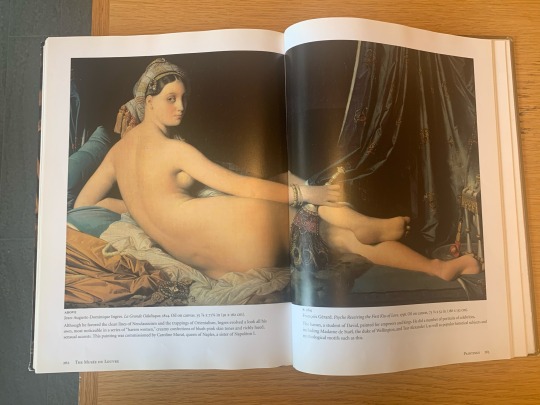
[La Grande Odalisque, Jean-Auguste-Dominique Ingres, 1814. Commissioned by Caroline Bonaparte, Napoleon’s youngest sister]
Excerpt from Ingres: Painting Reimagined, by Susan L. Siegfried
The Grande Odalisque exploited the balance between ideal figures and portraits in its artistic models and pushed that equilibrium to the limit. It was easily destablized by the directness of the odalisque’s gaze, even though the face was an idealized Raphaelesque type. Indeed, Ingres was unable to control rumors that he had portrayed Caroline Murat in the Grande Odalisque […]
The rumors were hardly surprising. Caroline Murat’s kinship with Pauline Borghese must have incited speculation, especially among enemies of the Bonapartes in Italy, about the Bonaparte women’s taste for disguised portraits of themselves in the nude.
[Pauline Bonaparte as Venus, by Canova]
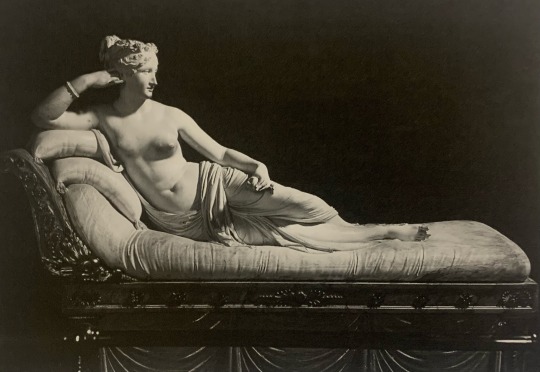
Moreover, in the eighteenth century the king’s mistresses used to commission portraits of themselves in the guise of sultanas, as did Madame de Pompadour in A Sultana Drinking Coffee by Carle Van Loo (1752, The State Hermitage Museum, St. Petersburg), so there was precedent for thinking that a “parvenu princess,” if not a mistress, may have followed suit. […]
Another ornament with a story behind it is the large and distinctively coiled bracelet worn by the Grande Odalisque. This bracelet closely imitates one in Giulio Romano and Raphael's portrait of Doña Isabel de Requesens i Enriquez de Cardona-Anglesola, known in the early nineteenth century as Raphael's portrait of Jeanne d'Aragon. Vasari identified the sitter as the vice-queen of Naples, and Ingres would easily have made the connection to the new queen of Naples, Caroline Murat.



He owned an engraving of the portrait, and he was also thinking about portrait painting at the time, since the occasion for his visit to the Royal Palace of Naples was portrait commissions of the Murat family. To identify Caroline Murat by means of a bracelet may seem obscure, and that is perhaps the case. However, Ingres’s study of ancient costume had taught him that particular articles of clothing were invested with meaning: for example, he had traced the entire history of ownership of the necklace of Eriphile, a work of Vulcan that was passed on by Venus and had dire consequences for whoever owned it.
#Jean-Auguste-Dominique Ingres#Ingres#Jean Auguste Dominique Ingres#La Grande Odalisque#Grande Odalisque#napoleon#napoleonic era#napoleonic#napoleon bonaparte#Caroline Bonaparte#Caroline#Caroline Murat#Napoleon’s sisters#Napoleon sister#first french empire#19th century#french empire#Naples#Italy#French art#louvre#art history#history of art#Susan L. Siegfried#Siegfried#Ingres: Painting Reimagined
11 notes
·
View notes
Text
THIS DAY IN GAY HISTORY
based on: The White Crane Institute's 'Gay Wisdom', Gay Birthdays, Gay For Today, Famous GLBT, glbt-Gay Encylopedia, Today in Gay History, Wikipedia, and more

44 BC – Italy: The first written reference to same-sex marriage appears when Cicero insults promiscuous Mark Antony whose father Curio "established you in a fixed and stable marriage, as if he had given you a stola." A stola is a traditional garment worn by married Roman women. Cicero’s sexual implications are clear, the point of which is to cast Antony in the submissive role in the relationship and to impugn his manhood.

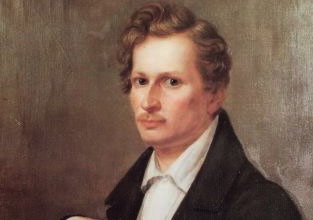
1796 – The poems of Count August von Platen (d.1835) are homoerotic expressions of Platonic love, idealism, beauty, friendship, and longing. Platen was born in Ansbach, Bavaria, the son of an impoverished nobleman. He attended the Military Academy at Munich and the Royal Institute of Pages resulting in his commission as a lieutenant in 1815 in a regiment against France during the time of Napoleon; he, however, engaged in no action.
Platen was extremely erudite, mastering a dozen languages, including literary Greek and Latin, French for social status, Persian for poetic reasons, and even English.
An admirer of Michelangelo and Italian art, Platen visited Florence, Rome, Naples, Syracuse, and Sicily. While in Naples in the 1820s, he formed a homosexual friendship with the poet and painter August Kopisch, all the while perfecting the content and form of his poetry. By 1826, he had moved permanently to Italy, supported by a pension from his friend, King Ludwig I of Bavaria.
Focusing his sexual urges into the artistic and creative realms, Platen transformed his passion for same-sex relations from the physical to the intellectual. On occasion, a friendship lasted only a year or so—for example, his intense relationship with a young painter, Rühl—but it nevertheless served to heighten his creative powers.
His controversial, multilingual, autobiographical narrative, which contains an explicitly erotic homosexual theme, was not published until the end of the nineteenth century, under the title Diary (Die Tagebücher, 1896-1900). In his poetry, Platen employs a recurrent homoerotic image borrowed from Persian poetry, the tulip, which is a spiritual symbol for masculine love.
Platen's longing for love and friendship is a persistent motif in his work. He addressed seven sonnets to "Cardenio," an Erlangen student, who is described as a young, tall, dark, and handsome man with full lips. Platen addressed an additional twenty-one sonnets to another Erlangen student, "Karl Theodor German." Embodying themes of Platonic love, friendship, longing, idealism, and beauty, Platen's sonnets express unrequited love for men.
Platen's homosexuality is the subject of a vicious attack by Heinrich Heine in The Baths of Lucca. Edward Carpenter, however, expressed his appreciation for Platen in his Ioälus, An Anthology of Friendship (1902). Among German writers who admired Platen is Thomas Mann, who praised him in a lecture in 1930; Platen's poem "Tristan" (1825) inspired Mann's novella Tristan and Isolde (1903).


1820 – Seventeen year old Ralph Waldo Emerson wrote of his crush on fifteen-year old Martin Gay: I begin to believe in the Indian doctrine of eye fascination. The cold blue eyes of (blank) has so intimately connected him in my thoughts & visions that a dozen times a day & as often by night I find myself wholly wrapped up in conjectures of his character and inclinations. We have already two or three long profound stares at each other. Be it wise or weak or superstitious I must know him.


1960 – Bradley Darryl BD Wong is an American actor, best-known for his roles as Dr. George Huang on Law & Order: Special Victims Unit, as Father Ray Mukada on HBO's Oz, Henry Wu in the movie Jurassic Park, and for his starring role as Song Liling in the Broadway production of M. Butterfly.
Wong gained attention for his Broadway debut in M. Butterfly opposite John Lithgow. The play won multiple awards, including several for Wong. He is notable as the only actor to be honored with the Tony Award, Drama Desk Award, Outer Critics Circle Award, Clarence Derwent Award, and Theatre World Award for the same role.
In 2008, he starred in the one-man show Herringbone, in which he portrays 11 roles, at the McCarter Theatre at Princeton University.
Wong, who is openly gay, began a long-term relationship with talent agent Richie Jackson in 1988. In 2000, Wong had twin sons: Boaz Dov, who died 90 minutes after birth, and Jackson Foo Wong. They were born through a surrogate mother, using Wong's sperm and an egg donated by Jackson's sister. In 2003, Wong wrote a memoir about his experiences with surrogacy titled Following Foo: the Electronic Adventures of the Chestnut Man. Wong and Jackson ended their relationship in 2004.
Wong very strongly identifies as a gay man. Hence, he has been a visible presence at AIDS-related charity functions and in gay and lesbian community events, as well as at events sponsored by the Asian Pacific Islander communities. Wong has appeared at the GLAAD Awards, made promotional spots for the gay and lesbian television newsmagazine In the Life, and worked in various ways to further understanding among both Asians and non-Asians, gays and non-gays, about the experience of being both gay and Asian.


1964 – Dan Mathews is the Senior Vice President of People for the Ethical Treatment of Animals. He is known for heading PETA's most controversial and attention-getting campaigns, including the "I'd Rather Go Naked Than Wear Fur" ads, as well as campaigns involving celebrities such as Morrissey, Pamela Anderson, Pink, and Paul McCartney.
He started poor, was bullied in high school, worked at McDonalds and as a model to put himself through American University, and after graduating started at PETA as a receptionist.
In 2000, he was named by gay lifestyle magazine Genre as one of the most influential people of the new century. When asked by the magazine whom he considered an influential gay person, he replied, spree killer "Andrew Cunanan, because he got Gianni Versace to stop using fur." In 2007, Mathews was ranked 37th in Out magazine's "50 Most Powerful Gay Men and Women in America".
Mathews has written a memoir, Committed: A Rabble-Rouser's Memoir, which he characterized as "an adventure story. It's like 007 wearing freaky outfits". The book tells the story of how he became a public person, the various exploits he's undertaken for PETA, and different campaigns he has done.

In May 2009 he commented on the actions of the governor general of Canada who, in participating in an Inuit tradition, consumed a raw seal heart. He is quoted as saying to the Toronto Star, "It amazes us that a Canadian official would indulge in such bloodlust. It sounds like she's trying to give Canadians an even more Neanderthal image around the world than they already have." Although Mathews admits to being attracted by extremes, he states that he and PETA engage exclusively in legal activities, but they do not necessarily condemn the actions of animal rights extremists.

1912 – The Arizona Supreme Court rules that fellatio is not outlawed by the term "crime against nature."

1981 – The first National Conference on Lesbian and Gay Aging was held in California, sponsored by the National Association for Gay and Lesbian Gerontology. It sought to "dispel myths about older lesbians and gay men, advance research, establish programs and services for lesbian and gay elders, and encourage and provide support for lesbian and gay gerontologists."


8 notes
·
View notes